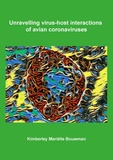Unravelling virus-host interactions of avian coronaviruses

Bouwman, Kim
- Promoter:
- Prof.dr A. (Andrea) Gröne
- Co-promoter:
- Dr M.H. (Hélène) Verheije & dr R.P. (Robert) de Vries
- Research group:
- Gröne
- Date:
- September 1, 2020
- Time:
- 16:15 h
Summary
Virus-host interactions are critical determinants for establishing an infection in a particular host which may subsequently lead to pathogenesis. The differences in such interactions, explaining the observed differences in outcome in host and tissue tropism of closely related avian coronaviruses, were at the start of this research largely not understood. This thesis focused particularly on unraveling the first step in the infection of avian coronaviruses, that is, the binding of the viral attachment protein spike to attachment factors (termed (host-) receptor or ligand) present on host cells. To this end in chapter 2, we compared host tissue binding of recombinantly expressed receptor binding domain (RBD) of nephropathogenic IBV-QX with that of respiratory IBV-M41. QX-RBD binding was dependent on a different sialylated ligand compared to that used by M41-RBD and structural analysis revealed that both ligand binding sites were located at a different side of the spike protein. Only three amino acids in QX-RBD were sufficient to render M41-RBD with the ability to bind to the kidney, while the reciprocal mutations in QX-RBD were detrimental for binding. These data suggest that differences in glycan binding preferences likely contribute to the altered in vivo tissue tropism of these viruses. In chapter 3 the role of posttranslational N-glycosylation of virulent IBV-M41 was studied using recombinant RBD proteins. We demonstrated glycan occupancy for M41-RBD and showed that six-out-of-ten N-glycans in the RBD are essential for binding to chicken trachea ex vivo . This study was extended in chapter 4, where we revealed the functional consequences of N-glycosylation of the RBD on binding, infection, and replication of recombinant IBV viruses generated by reverse genetics. Five-out-of-nine N-glycosylation mutants lost the ability to bind Neu5Ac, but gained binding to a new unknown receptor, while the growth kinetics of all mutants remained unaltered. Thus, N-glycosylation of the RBD of the spike of IBV-M41 is in vitro merely a determinant for receptor specificity. Finally, in chapter 5, the virus-host interactions and receptor specificity of a novel guinea fowl CoV identified in France in 2014 were compared to that of GfCoV/FR/2011. Tissue and glycan array binding data together revealed that S1 of the novel GfCoV has increased avidity for gastrointestinal tract as well as for the previously identified diLacNAc receptor. In addition, we showed that both the 2014- and 2011-GfCoV bind, in contrast to TCoV, to glycans capped with alpha-2,6-linked sialic acids. Overall, the diversity in GfCoV-S1 proteins results in differences in glycan and tissue binding properties and are thus important determinants for tissue and host tropism.